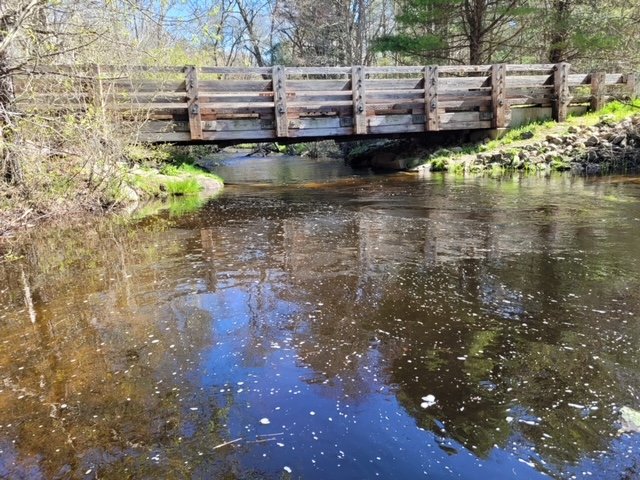Water Monitoring
May 7, 2024 -Jeff Perry and Joe Coppola kicked off the 2024 water monitoring by collecting water samples and taking temperature and Dissolved Oxygen readings from four rivers - Moosup, Flat, Falls and Wood. The samples and data are brought to the URI Watershed Watch lab for Bacteria and Chlorophyll analyses and recording the data. Monitoring at these locations is done monthly from May through October.
October 25, 2024 - this morning we completed the fourth and final sample collections and meter readings for 2024. The water is definitely cooling but lack of rain has created extremely low water levels in the watershed.
2003 - Lawson Cary, Jr. demonstrating water monitoring techniques to URI Watershed Watch technician at Chipuxet River in Kingston, RI.
The URI Watershed Watch Program (https://web.uri.edu/watershedwatch/) started as a cooperative volunteer water monitoring program with the Wood-Pawcatuck Watershed Association (WPWA) in 1988. The goal of the program is to provide current information and the status of ongoing trends of the quality of select water bodies in Rhode Island to communities, shore-side landowners, local residents, and recreational users so that they will understand what was going on in their local waters and cooperatively manage and improve their local waters. Rhode Island Trout Unlimited joined this volunteer initiative soon after its formation. We thank the early TU volunteer water monitors - Lawson Cary, Jr. and Al Ball – as they were instrumental in getting the chapter involved in water monitoring, and Ron Marafioti who was instrumental in maintaining the focus on this program that still exists today at four sites from May through October.
Monthly monitoring is currently performed at the following locations:
Moosup River at
Barbs Hill Road, Coventry
Meter readings are taken for Temperature and Dissolved Oxygen; water samples are taken to measure Bacteria.
Wood River at
Rte. 165 Check Station
Meter readings are taken for Temperature and Dissolved Oxygen; Water samples are taken to measure Bacteria and Chlorophyll.
Flat River at Midway
Meter readings are taken for Temperature and Dissolved Oxygen; Water samples are taken to measure Bacteria and Chlorophyll.
The Falls River at
Austin Farm Road
Meter readings are taken for Temperature and Dissolved Oxygen; Water samples are taken to measure Bacteria and Chlorophyll.
Water Temperature – a general measure of the water’s ability to support aquatic lifeforms.
Dissolved Oxygen – a specific measure of the water’s ability to support aquatic lifeforms.
Bacteria – specifically Enterococci, which comes from animal waste – a bacteria level above 60 ENT/100m can be harmful to people and pets.
Chlorophyll – to check the presence of algal material that may have migrated from headwaters or other ponds, and a measure of the productivity (i.e., available food).





